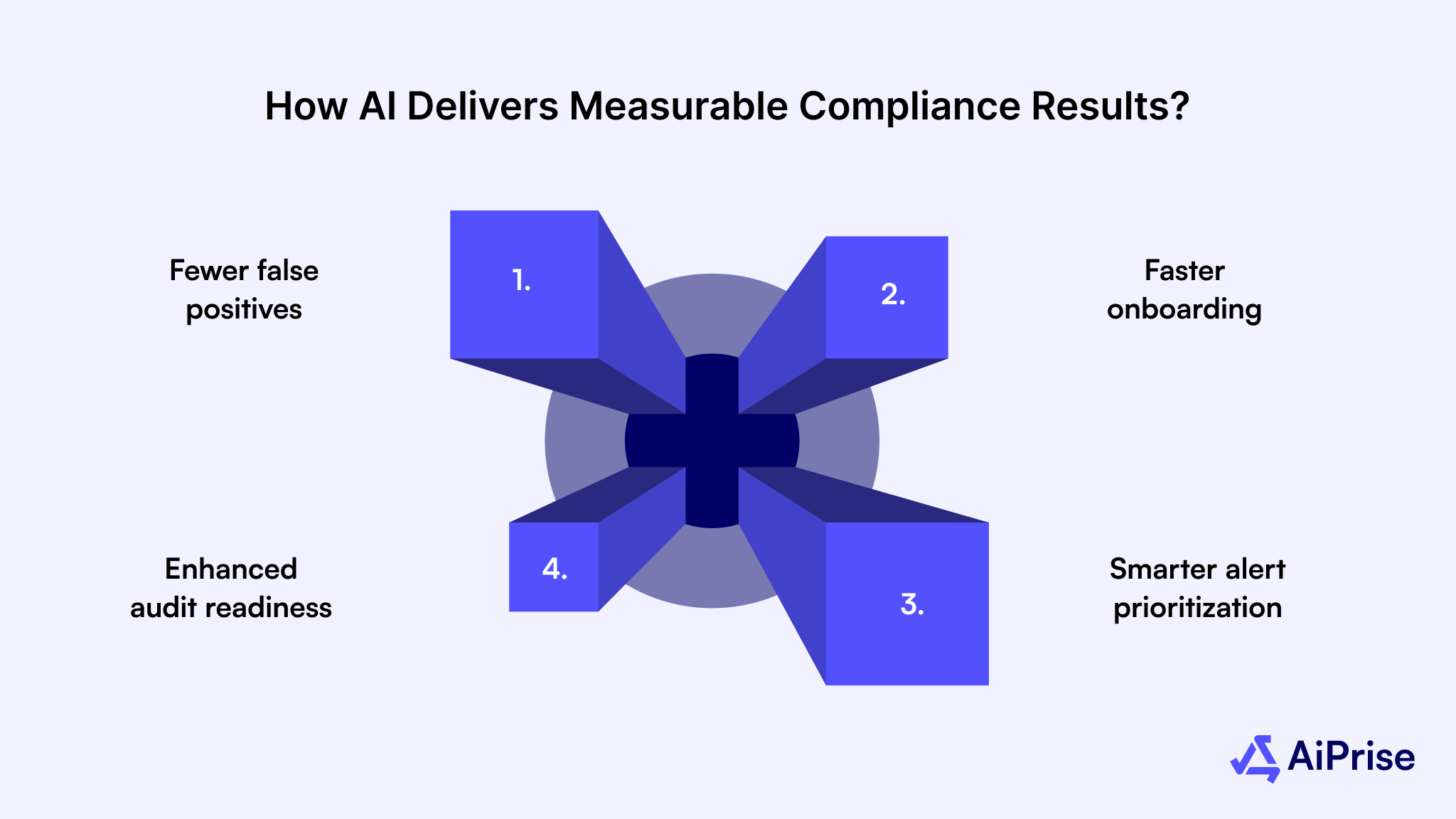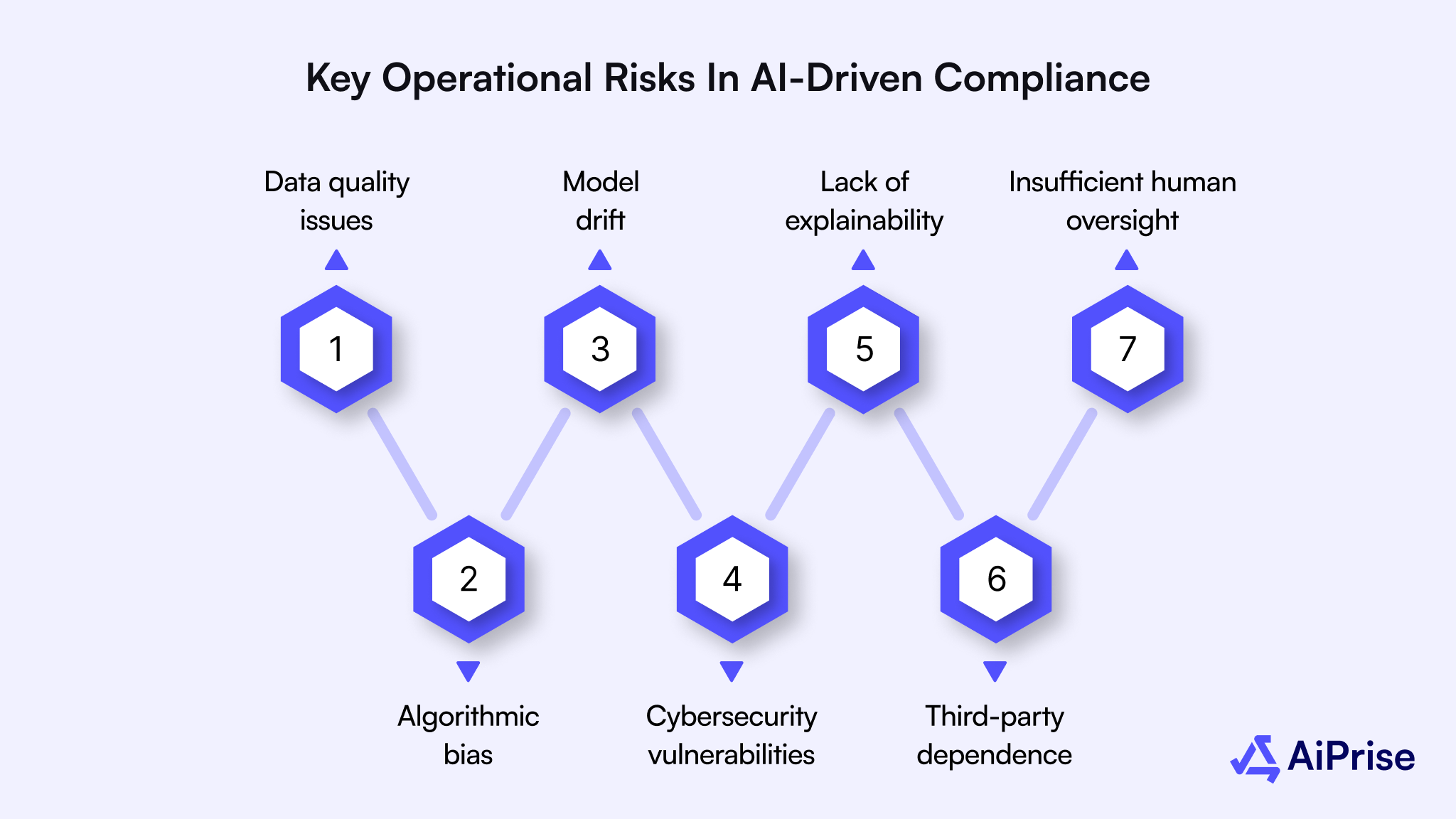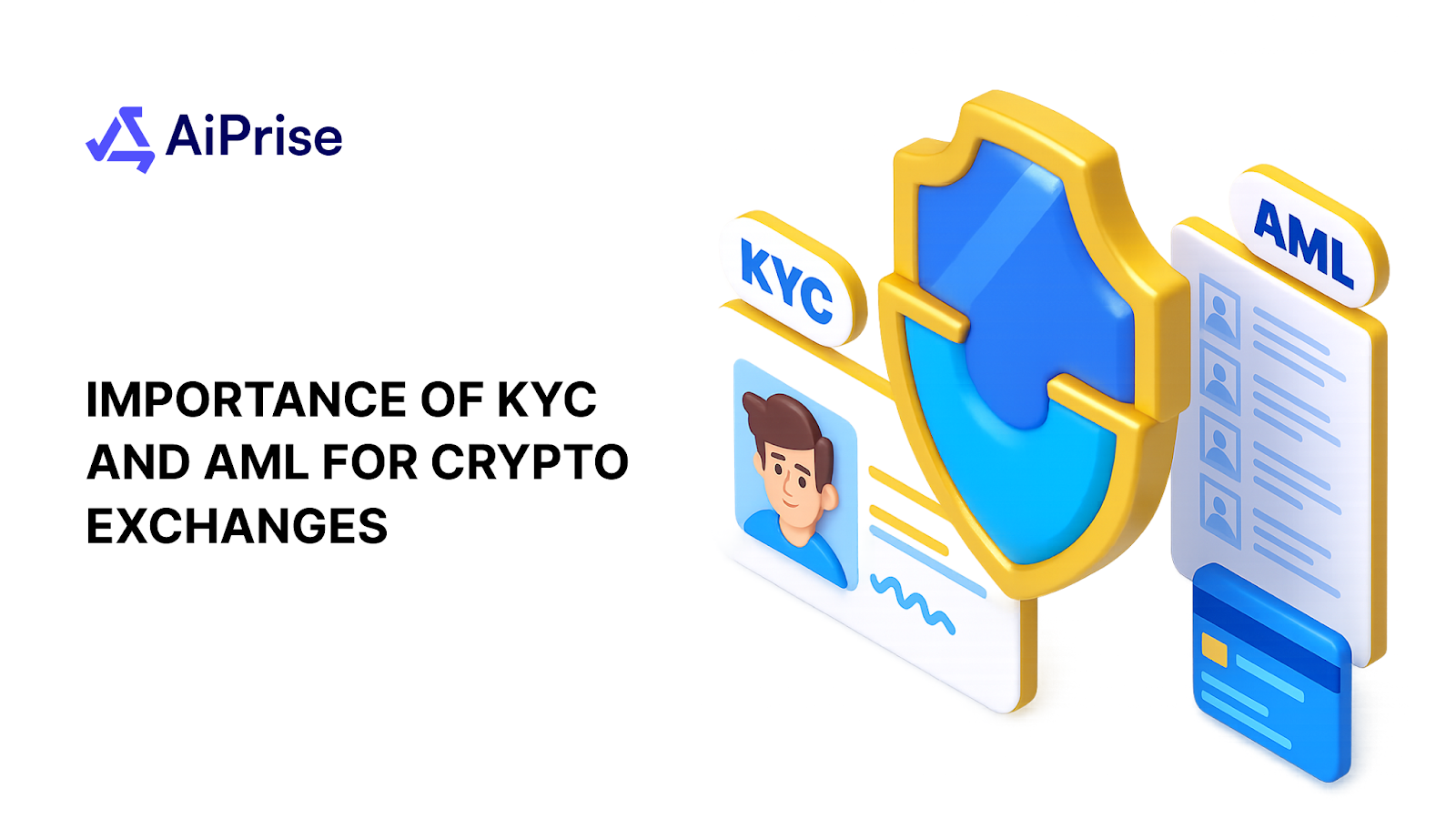AiPrise
10 min read
November 24, 2025
How AI is Transforming Compliance in Banking

Key Takeaways










Can your compliance team realistically detect sophisticated laundering and fraud while handling soaring alerts and tighter regulatory scrutiny?
You’re dealing with a tidal wave of alerts, slow manual KYC onboarding that frustrates customers, overtaxed analysts juggling investigations, and frequent regulatory audits that raise serious exposure. FinCEN’s 2025 Year-in-Review reports about 4.7 million suspicious activity reports filed during fiscal year 2024. Understanding this concentration helps you prioritize automation to cut triage time, reduce false positives, and focus investigations.
Quick Overview
- AI for compliance in banking automates monitoring, onboarding, and reporting, reducing manual workload and improving regulatory accuracy.
- Real-world results include faster KYC checks, fewer false positives, and more efficient investigations through smart alert prioritization.
- Leading U.S. banks already use AI to modernize fraud detection, audit readiness, and compliance governance with measurable gains.
- Responsible adoption with clear governance, data integrity, and human oversight ensures compliance remains transparent, secure, and regulator-ready.
How AI Is Transforming Compliance in Banking?
Compliance teams in banking face mounting regulatory pressure, rising alert volumes, and slower investigations that strain limited analyst capacity. AI enables faster detection of suspicious activity, automatically categorizing alerts and reducing false positives that drain valuable compliance hours. Advanced systems streamline KYC verification, documentation, and continuous monitoring, freeing compliance officers to focus on judgment-driven decisions and audit readiness. Understanding these transformations allows your institution to strengthen risk oversight, maintain regulatory confidence, and achieve measurable efficiency gains across compliance operations.
These improvements come to life through specific, real-world use cases where AI reduces complexity and boosts compliance performance.
Practical Use Cases of AI in Banking Compliance
AI for compliance in banking simplifies complex, time-consuming regulatory tasks by automating monitoring, reporting, and verification processes. Here are the most impactful use cases that directly address operational bottlenecks and compliance inefficiencies your institution faces today.

1. Enhanced Transaction Monitoring
Financial transactions demand round-the-clock surveillance to detect suspicious activities that manual teams may overlook. AI-driven monitoring systems analyze transaction patterns in real time, identifying unusual behaviors across accounts or geographies within seconds. This proactive detection enables your compliance team to respond faster, prevent potential fraud, and ensure adherence to AML obligations efficiently.
2. Automated KYC and KYB Verification
Identity verification remains one of the most resource-intensive aspects of compliance operations in banking. AI solutions use OCR and biometric tools to validate documents instantly, reducing onboarding delays and minimizing human error. Automation not only accelerates verification but also ensures every new account meets regulatory standards with greater accuracy and consistency.
3. Risk Assessment and Alert Prioritization
High alert volumes overwhelm analysts, causing delays in investigating critical compliance cases. Machine learning algorithms prioritize alerts by severity and relevance, ensuring the most significant risks receive immediate attention. This intelligent triage reduces alert fatigue, streamlines investigations, and enhances your overall compliance efficiency without increasing team size.
4. Continuous Regulatory Reporting
Frequent policy changes challenge financial institutions to maintain accurate and timely reporting to regulators. AI systems automatically extract, compile, and validate data required for compliance submissions, minimizing manual data handling and entry errors. By automating reporting cycles, your institution sustains transparency and stays compliant even as regulatory frameworks evolve rapidly.
5. Fraud Detection and Prevention
Sophisticated fraud schemes now use synthetic identities and layered transactions that bypass traditional screening tools. AI models detect hidden connections among entities, identifying fraudulent behavior before it escalates into regulatory exposure or financial loss. Integrating these models within compliance workflows strengthens risk mitigation and preserves customer trust across every financial touchpoint.
While these use cases show promise, responsible implementation determines whether AI truly improves compliance or creates new challenges.
Also read: Understanding Financial Crime Compliance And Risk Management

Implementing AI Responsibly in Banking Compliance
Responsible use of AI for compliance in banking protects credibility, builds regulator trust, and prevents technology from creating new risks. Here are the essential practices that help your compliance team apply AI safely, transparently, and in full alignment with regulations.
- Clear governance keeps AI decisions accountable, ensuring compliance actions remain explainable and aligned with internal oversight standards.
- Strong data foundations guarantee accurate risk models and eliminate bias that can damage customer trust or trigger regulatory concerns.
- Transparent algorithms make every compliance outcome traceable, so regulators clearly see how alerts and decisions were formed.
- Regular validation prevents model drift, maintaining consistency in monitoring suspicious activities as fraud patterns evolve over time.
- Human judgment stays central, balancing automation with expert oversight in complex or high-stakes compliance investigations.
- Secure data controls safeguard customer identities while meeting privacy and AML data retention requirements across jurisdictions.
- Structured vendor checks confirm third-party AI tools meet your internal governance and ethical use commitments.
- Ongoing training builds team confidence, ensuring compliance officers can interpret AI findings instead of depending blindly on them.
- Ethical deployment reinforces fairness and transparency, reducing compliance risks while strengthening long-term institutional integrity.
Once implemented responsibly, the next question becomes, what tangible results can your teams expect to see?
How AI Delivers Measurable Compliance Results?
Integrating AI for compliance in banking brings measurable efficiencies that ease manual pressure and strengthen regulatory performance. Here are the most significant gains your compliance teams can realize through intelligent automation and data-driven insights.

- Fewer false positives mean compliance analysts spend less time reviewing low-risk alerts, improving overall monitoring accuracy and focus.
- Faster onboarding becomes routine as AI automates document validation and identity checks, cutting delays that frustrate customers and staff.
- Smarter alert prioritization improves investigator productivity, ensuring high-risk transactions receive timely attention and thorough review.
- Enhanced audit readiness ensures every compliance activity is tracked and accessible, simplifying regulatory reviews and maintaining transparency.
These improvements are most visible when comparing traditional compliance workflows with AI-powered alternatives side by side.
Also read: Announcing our 12.5M Series A for AI powered Global Compliance
Manual vs AI-Driven Compliance in Banking
Traditional compliance processes rely heavily on manual checks, while AI for compliance in banking introduces automation, accuracy, and scalability. The table below outlines how modern AI systems outperform legacy methods across key compliance areas, improving efficiency and regulatory confidence.
To experience these benefits at scale, a structured rollout strategy ensures consistency, accuracy, and regulatory alignment from day one.
Practical Steps for Rolling Out AI in Compliance
Introducing AI for compliance in banking requires structured planning to ensure reliable results, regulatory acceptance, and smooth adoption across teams. Here are the essential steps that help your institution implement AI responsibly while maintaining accuracy, control, and operational efficiency.
- Begin with a focused pilot in a low-risk area, such as transaction monitoring or document verification, to validate outcomes safely.
- Consolidate and clean compliance data beforehand to ensure the AI model learns from accurate, complete, and unbiased information.
- Establish measurable KPIs like false positive rates, alert resolution time, and analyst efficiency to track tangible performance gains.
- Create human-in-the-loop workflows so compliance experts review AI decisions, correct inaccuracies, and continuously refine model reliability.
- Maintain transparent documentation that records data sources, model logic, and validation outcomes for easy audit and regulator reference.
- Conduct periodic security tests to identify vulnerabilities, including synthetic identities or deepfake manipulation within verification processes.
Some of the most advanced banks have already executed these steps, setting the pace for compliant and scalable AI adoption.
Also read: AI-Powered KYB Solutions for Streamlined Business Verification
Leading U.S. Banks Using AI Today
These real-world deployments show AI for compliance in banking moving from pilots to production at major U.S. institutions. Here are some of them:
- JPMorgan Chase: JPMorgan’s COiN program automates legal and contract review, cutting thousands of lawyer hours. The firm also runs enterprise AI platforms that improve payment fraud detection and transaction monitoring at scale.
- Bank of America: Bank of America reports broad AI adoption across operations, embedding automated tools to boost compliance productivity and streamline transaction searches. The bank emphasizes governance and workforce adoption as part of its AI rollout.
- Capital One: Capital One applies machine learning for real-time fraud detection across cards and auto lending, launching tools that flag suspicious behavior and reduce losses. Their public tech notes describe production ML models that protect customers and accelerate investigations.
- Wells Fargo: Wells Fargo has created dedicated AI teams to modernize controls, improve monitoring, and automate manual compliance tasks as part of its technology transformation. The bank is balancing innovation with regulatory remediation and governance.
While adoption grows, it’s equally important to recognize and mitigate the operational risks that accompany AI integration in compliance systems.
Key Operational Risks in AI-Driven Compliance
Integrating AI for compliance in banking introduces new operational risks that must be carefully managed to maintain trust and regulatory alignment.
Here are the primary challenges your compliance and risk teams should anticipate when deploying and scaling AI solutions.

- Data quality issues can distort model outputs, leading to inaccurate risk scores and potential compliance reporting errors.
- Algorithmic bias may emerge if training data reflects historical patterns that unfairly flag specific customers or geographies.
- Model drift occurs when changing fraud tactics or data inputs reduces AI accuracy, requiring continuous monitoring and retraining.
- Cybersecurity vulnerabilities in AI systems expose sensitive data to breaches or manipulation, especially in cloud-based compliance models.
- Lack of explainability makes it difficult for auditors or regulators to understand AI decisions, slowing approvals and increasing oversight pressure.
- Third-party dependence on external AI vendors or data sources can create concentration risks if providers face outages or compliance failures.
- Insufficient human oversight may cause critical compliance decisions to bypass expert review, undermining accountability in investigations.
Managing these risks effectively requires purpose-built tools designed for accuracy, auditability, and regulatory confidence, something AiPrise delivers with precision.

Accelerate Compliance with AiPrise Compliance Co-Pilot
Empower your compliance teams with AI for compliance in banking that acts as a true partner, not just another tool.
The AiPrise Compliance Co-Pilot automates verification, simplifies investigations, and enhances decision-making accuracy from day one.
Here’s how it helps your institution save time, strengthen compliance, and stay ahead of regulatory demands.
- Smart Document Analysis: Extract and verify key details from global ID documents in seconds, eliminating manual reviews and accelerating KYC/KYB processing.
- Compliance Co-Pilot Assistance: Work side-by-side with an intelligent co-pilot that learns from analyst decisions, improving accuracy, consistency, and case resolution speed.
- Automated Sanctions Screening: Detect and block high-risk individuals or entities instantly with AI-driven sanctions list screening and continuous watchlist updates.
- Dynamic Risk Scoring: Gain real-time, AI-calculated risk insights that prioritize investigations and trigger enhanced due diligence when needed.
- Comprehensive UBO Verification: Identify ultimate beneficial owners and hidden business connections, ensuring transparency across complex ownership structures.
- Continuous Monitoring: Receive proactive alerts on customer or business profile changes, enabling timely risk responses and ongoing regulatory compliance.
- Branded, Streamlined Onboarding: Create a secure, on-brand onboarding experience that reinforces trust and compliance while reducing drop-offs and friction.
Experience 95% faster compliance reviews, 10x onboarding speed, and smarter, more accurate decisions with AiPrise.
Conclusion
AI for compliance in banking is redefining how financial institutions manage risk, detect fraud, and maintain regulatory trust. Adopting intelligent automation helps reduce manual errors, enhance oversight, and streamline complex processes that once slowed compliance operations. This shift allows compliance teams to focus on strategic analysis and decision-making rather than repetitive administrative tasks.
AiPrise simplifies this transformation with its AI-driven Compliance Co-Pilot that delivers faster, smarter, and more transparent compliance management. The platform unifies KYC, KYB, AML, and risk monitoring into one seamless system built for accuracy and scalability. With AiPrise, your institution can onboard faster, detect risks earlier, and maintain compliance confidence across every regulatory requirement.
Book your demo today and see how AiPrise transforms compliance efficiency with intelligent, AI-driven precision.
Frequently Asked Questions (FAQs)
1. How is AI changing compliance in banking?
AI is transforming compliance by automating monitoring, detecting suspicious activities faster, and reducing manual errors in regulatory reporting and verification processes.
2. What are the biggest challenges when adopting AI for compliance in banking?
Key challenges include maintaining data quality, ensuring algorithm transparency, preventing bias, and aligning automated decisions with strict regulatory requirements.
3. Can AI completely replace compliance officers in financial institutions?
AI cannot replace compliance officers; it supports them by handling repetitive tasks, allowing teams to focus on complex investigations and strategic oversight.
4. How do banks measure the success of AI-driven compliance programs?
Banks track performance through KPIs like reduced false positives, faster alert resolution, lower onboarding time, and improved audit accuracy.
5. What safeguards ensure responsible AI use in compliance operations?
Responsible use involves transparent documentation, regular model validation, human-in-the-loop reviews, and continuous audits to maintain ethical and regulatory integrity.
You might want to read these...

Aiprise has helped streamline our KYB (Know Your Business) flow in 100+ countries. No other tool comes close.





Speed Up Your Compliance by 10x
Automate your compliance processes with AiPrise and focus on growing your business.





















